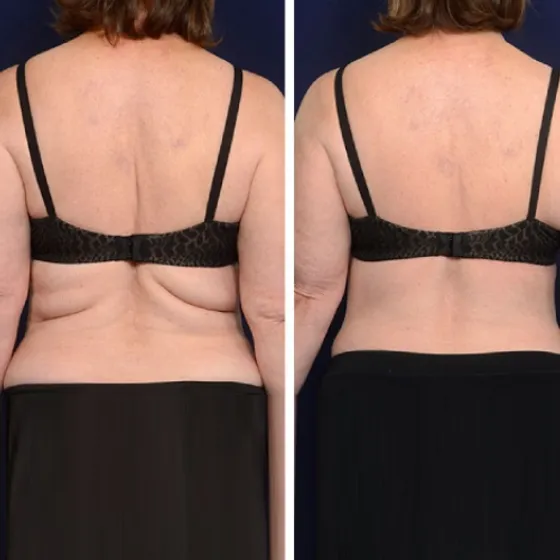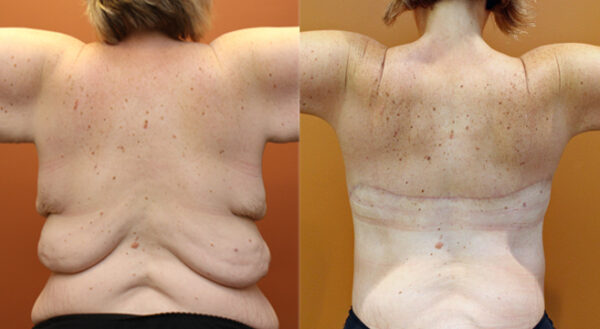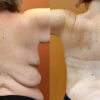Description
Familiarity with treatment
An upper body lift, also known as an upper body contouring or torsoplasty, is a surgical procedure that targets the upper back, chest, and arms. It is designed to remove excess skin and fat in these areas and tighten the remaining skin to create a more contoured and toned upper body appearance.
During an upper body lift, the surgeon will make incisions strategically placed to minimize visible scarring. The specific techniques used may vary depending on the individual’s needs and goals. The excess skin and fat are then removed, and the remaining skin is lifted and tightened. The incisions are typically placed in inconspicuous locations, such as along the bra line or within natural creases of the body.
The benefits of an upper body lift include:
- Improved upper body contour: An upper body lift can address sagging skin, excess fat, and tissue laxity in the upper back, chest, and arms. By removing the excess tissue and tightening the remaining skin, it can create a more sculpted and toned appearance.
- Enhanced body proportions: Excess skin and fat in the upper body can create an imbalance in body proportions. An upper body lift helps to restore balance and harmony to the overall body shape, resulting in improved body proportions.
- Reduction of skin laxity: Significant weight loss, aging, or other factors can lead to loose and sagging skin in the upper body. An upper body lift can effectively remove the excess skin and tighten the remaining skin, reducing skin laxity and improving skin elasticity.
- Improved self-confidence: Excess skin and fat in the upper body can be a source of self-consciousness for many individuals. By improving the appearance of the upper body, an upper body lift can help boost self-confidence and improve body image.
Who is it suitable for?
An upper body lift is suitable for individuals who have excess skin and tissue in the upper body area, including the chest, back, and arms. It is commonly performed on individuals who have lost a significant amount of weight, either through diet and exercise or bariatric surgery, and have loose, sagging skin as a result. Upper body lift surgery can help improve the contour and appearance of the upper body by removing excess skin and tightening the underlying tissues. It is important for individuals considering this procedure to be in good overall health and have realistic expectations about the results.
Who is it not suitable for?
An upper body lift may not be suitable for individuals who have certain medical conditions or factors that could increase the risks and complications associated with the surgery. Some factors that may make an individual not suitable for an upper body lift include:
- Poor overall health: Individuals who have significant medical conditions, such as uncontrolled diabetes, heart disease, or compromised immune systems, may not be suitable candidates for surgery.
- Obesity: If an individual is still significantly overweight or obese, it is generally recommended to reach a stable and healthy weight before considering an upper body lift. This is because the surgery is most effective when excess weight has already been lost.
- Smoking: Smoking can impair the healing process and increase the risk of complications during and after surgery. It is typically advised to quit smoking before undergoing any surgical procedure.
- Unrealistic expectations: It is important for individuals to have realistic expectations about the results of an upper body lift. Surgery can improve the appearance of the upper body, but it cannot completely eliminate all imperfections or guarantee a specific outcome.
- Pregnancy or plans for future pregnancies: Women who are planning to become pregnant in the future may be advised to postpone an upper body lift, as pregnancy can stretch the skin and reverse the effects of the surgery.
Advantages
There are several advantages to undergoing an upper body lift surgery. Some of the key advantages include:
- Improved body contour: An upper body lift can significantly improve the contour and shape of the upper body. It removes excess skin and tissue, resulting in a smoother and more toned appearance.
- Reduction of sagging skin: Individuals who have lost a significant amount of weight or have experienced skin laxity due to aging can benefit from an upper body lift. The procedure removes excess skin and tightens the underlying tissues, reducing sagging and creating a more youthful appearance.
- Enhanced self-confidence: Many individuals who have loose, sagging skin in the upper body area may feel self-conscious about their appearance. By undergoing an upper body lift, they can achieve a more aesthetically pleasing body contour, which can boost their self-confidence and improve their overall quality of life.
- Clothing fit: Excess skin and tissue in the upper body can make it challenging to find clothing that fits properly. After an upper body lift, individuals often find that clothes fit better and feel more comfortable.
- Improved physical comfort: Excess skin and tissue in the upper body can cause discomfort and irritation, especially when it rubs against clothing or causes chafing. An upper body lift can alleviate these physical discomforts and improve overall comfort.
Complications
Like any surgical procedure, an upper body lift carries potential risks and complications. It is important to be aware of these potential complications before undergoing the surgery. Some possible complications of an upper body lift include:
- Infection: There is a risk of developing an infection at the incision sites. This can usually be treated with antibiotics, but in severe cases, additional surgical intervention may be required.
- Poor wound healing: Some individuals may experience delayed or poor wound healing, which can result in wound separation or the formation of thick, raised scars.
- Bleeding: Excessive bleeding during or after the surgery is a potential complication. In rare cases, it may require additional surgical intervention to control the bleeding.
- Seroma: A seroma is a collection of fluid that can accumulate under the skin after surgery. It may require drainage with a needle or additional surgical intervention.
- Numbness or changes in sensation: Temporary or permanent changes in sensation, including numbness or altered sensation, may occur in the treated areas. This is usually temporary but can be permanent in rare cases.
- Asymmetry: There is a possibility of uneven or asymmetrical results, where one side of the body may appear different from the other.
- Scarring: While efforts are made to minimize scarring, an upper body lift will result in permanent scars. The extent and visibility of the scars can vary depending on individual healing and surgical techniques.
- Blood clots: There is a risk of developing blood clots, particularly in the legs (deep vein thrombosis). These clots can potentially travel to the lungs (pulmonary embolism), which can be life-threatening.
Preoperative care
Preoperative care is an essential part of preparing for an upper body lift surgery. It involves several steps and considerations to ensure the best possible outcome and minimize the risk of complications. Here are some common preoperative care guidelines for an upper body lift:
- Consultation and medical evaluation: Schedule a consultation with a qualified plastic surgeon to discuss your goals, medical history, and any concerns you may have. The surgeon will evaluate your overall health and determine if you are a suitable candidate for the procedure.
- Medical clearance: Depending on your medical history and current health status, your surgeon may request medical clearance from your primary care physician or other specialists to ensure that you are in good health for surgery.
- Stop smoking and avoid certain medications: If you smoke, it is important to quit smoking several weeks before the surgery, as smoking can impair healing and increase the risk of complications. Your surgeon may also advise you to avoid certain medications, such as blood thinners, herbal supplements, and non-steroidal anti-inflammatory drugs (NSAIDs), as they can increase the risk of bleeding.
- Follow preoperative instructions: Your surgeon will provide you with specific instructions to follow in the days leading up to the surgery. This may include guidelines on fasting before the procedure, showering with antibacterial soap, and avoiding certain skincare products.
- Arrange for transportation and support: Since an upper body lift is a major surgical procedure, you will need someone to drive you home after the surgery and provide assistance during the initial recovery period. Make arrangements for transportation and support in advance.
- Prepare your home for recovery: Before the surgery, make sure your home is clean and organized to facilitate a smooth recovery. Stock up on necessary supplies, such as loose and comfortable clothing, wound care supplies, and any prescribed medications.
- Follow dietary guidelines: Your surgeon may provide specific dietary guidelines to follow before the surgery. This may include avoiding certain foods and beverages, staying hydrated, and maintaining a balanced diet to support healing.
- Mental and emotional preparation: Undergoing surgery can be emotionally challenging. Take time to mentally prepare yourself for the procedure and discuss any concerns or anxieties with your surgeon. Consider seeking support from friends, family, or a therapist if needed.
Postoperative care
Postoperative care is crucial for a successful recovery after an upper body lift surgery. Following your surgeon’s instructions and taking proper care of yourself can help minimize complications and promote healing. Here are some general postoperative care guidelines for an upper body lift:
- Follow wound care instructions: Your surgeon will provide specific instructions on how to care for your incisions and dressings. It is important to keep the incision sites clean and dry, and to change dressings as directed. Follow any wound care protocols, such as applying antibiotic ointment or using special dressings.
- Take prescribed medications: Your surgeon may prescribe pain medications, antibiotics, and other medications to manage pain, prevent infection, and promote healing. Take these medications as directed and report any adverse reactions or concerns to your surgeon.
- Wear compression garments: Compression garments are often recommended after an upper body lift to help reduce swelling, support the tissues, and improve healing. Follow your surgeon’s instructions on when and how long to wear the compression garments.
- Manage pain and discomfort: It is normal to experience some pain, swelling, and discomfort after surgery. Use prescribed pain medications as directed, apply ice packs to reduce swelling, and rest as much as possible. Avoid strenuous activities and lifting heavy objects during the initial recovery period.
- Follow a healthy diet: Eating a nutritious diet can support healing and promote recovery. Follow any dietary guidelines provided by your surgeon, which may include consuming adequate protein, staying hydrated, and avoiding foods that may interfere with healing.
- Attend follow-up appointments: It is important to attend all scheduled follow-up appointments with your surgeon. These appointments allow your surgeon to monitor your healing progress, remove sutures if necessary, and address any concerns or complications that may arise.
- Gradually resume activities: Your surgeon will provide guidelines on when and how to gradually resume normal activities, including exercise and work. Follow these instructions to avoid straining the incisions and to allow your body to heal properly.
- Practice scar care: Proper scar care can help minimize the appearance of scars over time. Your surgeon may recommend scar massage, silicone gel sheets, or other scar management techniques. Follow their instructions on scar care to optimize healing.
- Seek support: Recovering from surgery can be physically and emotionally challenging. Seek support from friends, family, or support groups to help you through the recovery process. If you experience any emotional distress or have concerns, don’t hesitate to reach out to your surgeon or a mental health professional.
Only logged in customers who have purchased this product may leave a review.






Reviews
There are no reviews yet.